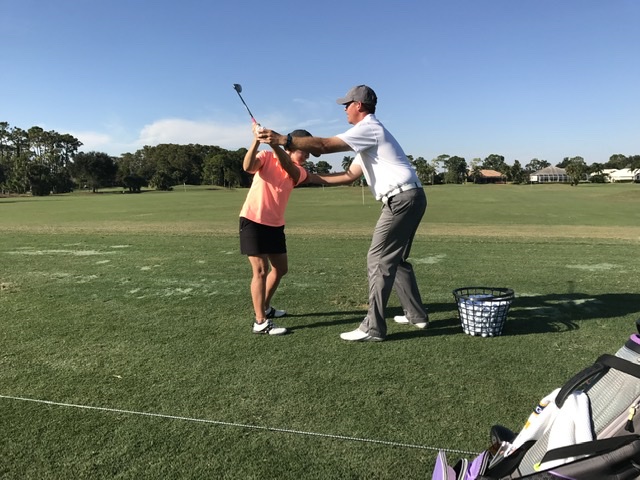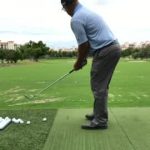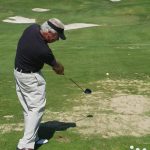Is it considered a bad thing for a golfer to have sway (lateral movement) in their backswing?
Stay Centered
There are several keys to NOT SWAYING!
First pre-swing–be sure to not get too wide of a stance. We all have heard shoulder width–but your feet are not attached to your shoulders–they are attached to your hips. Your stance should never get much wider than hip width with a driver and less with the irons. A too wide stance makes it hard to shift the weight without swaying. Second be sure to have a slight tilt in the spine toward your trail side. Picture included–I call this hip bump/spine tilt, slightly bump the hips toward the target and let the spine tilt away from the target, your lead side hip and shoulder should be higher than the trail side joints.
In swing–this is KEY! Turn the trail side shoulder away from the ball and toward your spine and behind your head and at the same time feel like you are turning the trail side hip and butt cheek toward the target. This will keep you centered over the ball and allow you to maintain the spine tilt you created at address.
Here are some good check points. 1. Your trail side foot should stay flat on the ground. 2. Your trail side knee should stay inside your trail side foot. 3. Your head may move “off” the ball some but not a lot. 4. Your weight should be toward the trail side heel.
All good players LOAD into their trail side and do so without swaying–if you sway you are not getting loaded correctly and will make it very tough to get back into a proper impact position.
Utilize Sway Correctly to Create Efficiency
The term “sway” in a golf swing can carry a lot of meaning, both good and bad. First, to define sway, we are normally speaking about lateral shift of the body in the backswing (only). To take it a step further, we generally assess “sway” in two body segments: the pelvis (lower body) and the torso (upper body). Think of your belt buckle as the pelvis and your shirt buttons as your torso.
It’s important to note that we can look at each segment individually. For a right-handed golfer for example, the pelvis can sway to the right in the backswing, while the torso might remain stable. Or, the torso can sway to the right, while the pelvis remains stable. Or, both segments could sway rightward together! Looking at each part of the body individually helps us as teachers best identify a player’s movements and how we can increase their efficiency. Finding a quality coach can help you identify your specific tendencies and evaluate if there is room for improvement.
In general, though, swaying of the torso and pelvis to the right in the backswing a slight bit (1-2 inches) is common, as players will shift pressure into their trail foot at the same time as they load the club going back. The key with sway is to understand that if the body sways in the backswing it will need to re-center in the transition/downswing. Players who get into trouble with sway either sway too much in the backswing (more than a few inches), or don’t re-center themselves soon enough in the downswing. At impact you want the pelvis (especially) more forward (toward the target) than it was at address, so keep this in mind as you work on the lateral movement of your golf swing.
Really want to improve your golf game? Get incredible swing tips delivered to your inbox every week.
Difference between swaying and lateral motion.
Swaying is when the heat moves laterally in the weight ships to the outside of the trail foot. This is a flawed pivot. Lateral motion is when the upper body moves back on the backswing but can be achieved without swaying. This is of benefit when loading up the driver swing and also for taking away the stress required in the backswing for older and less flexible golfers. Moving laterally behind the ball a little bit on the backswing with the driver makes it much easier to hit with an ascending angle of attack which reduces backspin and optimizes distance with the driver.
To sway or not to sway
The history of golf certainly has shown and continues to show that there are many ways to swing. Nowhere is that more true than in the backswing. It seems to me that many instructors today are very against lateral motion in the backswing. I’m not sure why because most of the players in the hall of fame utilized lateral motion. Some had giant moves off the ball, some not so much. I see many younger players working on swings that seem too centered almost to the point of a reverse pivot. I’m afraid many of these players have back and hip injury in their future.
Obviously swaying onto the outside of the trail foot can cause a host of impact problems as does a reverse pivot. Most of the greats did have lateral motion going back but most definitely had a re-centering move before reaching the top.
Going back some players moved / “swayed” their upper body / head back ie: Tiger, Strange, Hagen.
Some great players made a big shift back with their lower spine / hips ie: Monty, Couples, Inkster.
My preference is to see a bit of lateral motion with a strong re-centering move. This is a natural athletic motion and can become a key element to rhythm and balance. Practice throwing a ball to get the feel.
You Must Coil On Your Backswing
The topic of sway has been a hot button topic for decades. I have observed an entire industry misunderstand Jimmy Ballard. He has been labeled as a sway teacher. The truth is that in any good golf swing there must be a Coil Behind the ball in the backswing. If you look at all the best ball strikers in the history of the game, they have all coiled behind the ball. Trying to keep your head steady or down will create a reverse pivot and not allow a person to coil. There is a way to sway, but it is drastically misunderstood.
To Coil properly on your backswing, make sure your weight stays on the inside of the trail foot going back. A great way to feel this is to turn your back foot inward towards the ball. This creates a tight coil and will not allow your weight to get outside of your trail foot. This is what a proper coil should feel like. Do this and you will be well on your way to making a great golf swing.
Better to Stay Home than Sway
When a golfer addresses the ball, arms extended, they’re identifying the bottom of their swing arc. If a backswing includes excessive lateral movement back, it changes the bottom of that swing arc. The player would then need to “time up” the lateral movement back to the ball, with the arm swing, and the body rotation. It makes consistency of the strike very difficult to achieve. Unless your hitting 1,000 balls a week, I’d recommend staying home where your address started and focusing on more stationary rotation rather than trying to time the lateral movement back to the bottom.
Sway vs. Pressure Shift
I do not like the word sway as it relates to the golf swing. I think in general “sway” has a negative connotation and I’d prefer not to do it. There are a variety of shots in golf with a variety of optimal body motions. In general, the shorter the shot and swing, the less lateral shift, weight shift, etc… should happen on the backswing. I like an upper torso shift with the driver and potentially fairway woods and hybrids for most of my students. I always like a backswing pressure shift with a full swing, albeit the pressure shift is not seen by the naked eye or video.
Is a lateral movement away from the target on the backswing bad? It might create momentum for the downswing, but I do believe that it creates more opportunity for error and inconsistency for shots played off the ground.
Load Right Unload Left for Proper Contact
When we talk about the best golf swings in the world there is a loading of weight on the backswing and then a shift or unload into finish. No great player is flat footed in their finish position. That being said, there is very little head movement until impact in the best golf swings. I know I’m asking a lot but load and unload into the impact position with a quiet spine and head and I guarantee you have better results. After impact hold that finish position until the ball lands or stops rolling. Head quiet, load unload and hit your finish for proper contact. Good luck!!
Say "nay" to sway!
Moving laterally off of the ball, or “swaying” can be a real killer to an efficient move. As weight moves outside of the back foot, it makes it nearly impossible to get back to the ball, without throwing one’s hands and arms at the ball. This has a negative effect on the shape of the swing (plane), as well as on the speed. It causes the swing to bottom out at the wrong point of the arc, usually resulting in fat shots, with the occasional skull.
Getting your student to set up with more weight on the inside of the back foot, and maintaining it there through the completion of the backswing, will allow for a shift of the weight to the front foot, with arms following instead of leading. Consistency factor goes up, up, up!
Swaying happens in an Earthquake Not Golf
Swaying is when our Back Knee/ Hip move Lateral. So What can we do to remedy this??? Here are 3 options that may help our readership:
1st place a 6 irons against your back leg if done Correctly the club will turn behind you and fall toward the Ground. If not it could ride up your pant leg or shorts.
Next, cut a Tennis ball in Half place it under back foot IF You Turn then you should Feel the ball going into the ground.
Lastly, stand against the a WALL with your back side just touching as you turn back your Back Cheek should Touch the wall.
Sway good or bad?
If a golfer sways, it’s a definite power loss. When the sway occurs, the golfers posture, spine angle, and height changes causing the swing path to change causing an errant shot.
See The Remedy 4 Golf for a training aid that helps eliminate the sway.
Swaying is a killer
When golfer sway and move laterally it stops rotational movement and makes it extremely difficult to finish the golf swing. Often times swaying will lead to swings with lots of hand and arm movement to try and make up for the loss in swing speed due to lack of rotation. If the body won’t allow for rotational movement swaying can be used to help transfer weight, but should be avoided at all costs.
NOT A good habit
I believe that Swaying During the backswing is a very bad habit! Though lateral pressure to the right side during the backswing and then forward during transition can be a great source of power and is very important for sequencing, a lot of people overdo this into a fault. A very slight lateral motion; then allowing the right hip to rotate so the pelvis turns rather than sways is a much better habit to create !
Don't Sacrifice Balance
A little lateral motion in one’s backswing is not an issue unless balance is compromised. If the weight moves to the outside of the trail side (right for righties) foot, the only way to transfer the weight back to the left side for the down swing is with the upper body getting involved. That alters the natural path for the club, creating an over the top move. So, if your balance is good, don’t worry about it–freedom, rather than rigidity–is a good thing.
If it works...Don't fix it!!!
It’s all about ball flight…Sway, turn away or whatever, this may be the most comfortable movement for the student…
TLDR: What our Backswing professionals have to say on the topic “Sway or Lateral Movement in Golf Swing”:
- “Swaying during the golf swing, where the body moves excessively laterally, can lead to inconsistent ball striking and loss of power.”
- “Maintaining proper posture and balance is crucial to avoid excessive sway and promote a stable swing foundation.”
- “Engage the core muscles and focus on rotation rather than lateral movement to generate power and maintain control.”
- “Use alignment aids or swing drills to develop awareness and prevent excessive lateral movement.”
- “Practice with video analysis or seek professional guidance to identify and correct any sway or lateral tendencies.”
Minimizing sway or lateral movement in the golf swing is important for consistent ball striking and power generation. By focusing on proper posture, balance, rotational movement, and seeking guidance or utilizing video analysis, you can improve your swing mechanics and overall performance on the course.












